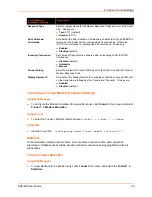
6: Line and Tunnel Settings
EDS-MD User Guide
37
Using the CLI
To view Line statistics:
enable -> line 1, show statistics
Using XML
Include in your file:
<statusgroup name=”line” instance=”1”>
Tunnel Settings
Tunneling allows serial devices to communicate over a network, without “being aware” of the
devices which establish the network connection between them. Tunneling parameters are
configured using the Tunnel menu and submenus.The Tunnel settings allow you to configure how
the Serial-Network tunneling operates. Tunneling is available on all serial Lines. The connections
on one serial Line are separate from those on another serial port.
Note:
The following section describes the steps to view and configure Tunnel 1 settings;
these steps apply to other tunnel instances of the device.
Serial Settings
These serial settings for the tunnel apply to the Serial Line interface. The Line Settings and
Protocol are displayed for informational purposes and must be configured from the Line settings.
Table 6-3 Tunnel Serial Settings
To Configure Tunnel Serial Settings
Using Web Manager
To configure the Serial Settings for a specific tunnel, click
Tunnel
in the menu and select
Tunnel 1 -> Serial Settings
.
Tunnel Serial
Settings
Description
Line Settings
Line Settings information here is display only. Go to the section,
To Configure
Line Settings
to modify these settings.
Protocol
Protocol information here is display only. Go to the section,
To Configure
Line Settings
to modify these settings.
DTR
Select the conditions in which the Data Terminal Ready (DTR) control signal
on the Serial Line are asserted. Choices are:
Unasserted
TruPort
= the DTR is asserted whenever either a connect or an accept
mode tunnel connection is active with the Telnet Protocol RFC2217 saying
that the remote DSR is asserted.
Asserted while connected
= the DTR is asserted whenever either a
connect or an accept mode tunnel connection is active.
Continuously asserted
















































